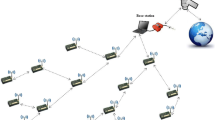Abstract
Cooperative transmissions have received recent attention and research papers have demonstrated their benefits for wireless networks. Such benefits include improving the reliability of links through diversity and/or increasing the reach of a link compared to a single transmitter transmitting to a single receiver (single-input single-output or SISO). In one form of cooperative transmissions, multiple nodes can act as virtual antenna elements and provide diversity gain or range improvement using space-time coding. In a multi-hop ad hoc or sensor network, a source node can make use of its neighbors as relays with itself to reach an intermediate node with greater reliability or at a larger distance than otherwise possible. The intermediate node will use its neighbors in a similar manner and this process continues till the destination is reached. Thus, for the same reliability of a link as SISO, the number of hops between a source and destination may be reduced using cooperative transmissions as each hop spans a larger distance. However, the presence of malicious or compromised nodes in the network impacts the benefits obtained with cooperative transmissions. Using more relays can increase the reach of a link, but if one or more relays are malicious, the transmission may fail. However, the relationships between the number of relays, the number of hops, and success probabilities are not trivial to determine. In this paper, we analyze this problem to understand the conditions under which cooperative transmissions fare better or worse than SISO transmissions. We take into consideration additional parameters such as the path-loss exponent and provide a framework that allows us to evaluate the conditions when cooperative transmissions are better than SISO transmissions. This analysis provides insights that can be employed before resorting to simulations or experimentation.


















Similar content being viewed by others
References
Jakllari G, Krishnamurthy SV, Faloutsos M, Krishnamurthy P, Ercetin O (2006) A framework for distributed spatio-temporal communications in mobile ad hoc networks. In: Proceedings of Infocom
Aksu A, Ercetin O (2008) Reliable multi-hop routing with cooperative transmissions in energy-constrained networks. IEEE Trans Wirel Commun 7(8):2861–2865
Eschenauer L, Gligor VD (2002) A key-management scheme for distributed sensor networks. Proceedings of the 9th ACM conference on computer and communications security (Washington DC), 41–47: CCS ’02. ACM, New York, pp 18–22
Laneman JN (2002) Cooperative diversity in wireless networks: algorithms and architectures. PhD dissertation, Massachusetts Institute of Technology, Cambridge, MA
Haykin S, Moher M (2005) Modern wireless communications. Prentice Hall, Englewood Cliffs
Alamouti SM (1998) A simple transmit diversity technique for wireless communications. IEEE J Sel Areas Commun 16(8):1451–1458
Tarokh V, Jafarkhani H, Calderbank AR (1999) Space-time block codes from orthogonal designs. IEEE Trans Inf Theory 45(5):1456–1467
Krikidis I, Thompson JS, McLaughlin S (2009) Relay selection for secure cooperative networks with jamming. Trans Wirel Commun 8(10):5003–5011
Sendonaris EEA, Aazhang B (2003) User cooperation diversity—part I: system description. IEEE Trans Commun 51(11):1927–1938
He X, Yener A (2008) Two-hop secure communication using an untrusted relay: a case for cooperative jamming. In: IEEE Globecom
Hanc Z, Sun YL (2007) Securing cooperative transmission in wireless communications. In: Proc Mobiquitous
Yu W, Liu KR (2005) Secure cooperative mobile ad hoc networks against injecting traffic attacks. In: Proc IEEE SECON
Chan H, Perrig A, Song D (2003) Random key predistribution schemes for sensor networks. In: SP ’03: Proceedings of the 2003 IEEE symposium on security and privacy. IEEE Computer Society, Washington, DC, USA, p 197
Du W, Deng J, Han YS, Varshney PK (2006) A key predistribution scheme for sensor networks using deployment knowledge. IEEE Trans Dep Sec Comp 3:62–77
Paulraj A, Nabar R, Gore D (2003) Introduction to space-time wireless communications. Cambridge University Press, Cambridge
Acknowledgement
This work was funded in part by the Army Research Office MURI grant W911NF-07-1-0318.
Author information
Authors and Affiliations
Corresponding author
Rights and permissions
About this article
Cite this article
Aksu, A., Krishnamurthy, P., Tipper, D. et al. On Security and Reliability Using Cooperative Transmissions in Sensor Networks. Mobile Netw Appl 17, 526–542 (2012). https://doi.org/10.1007/s11036-012-0360-8
Published:
Issue Date:
DOI: https://doi.org/10.1007/s11036-012-0360-8




